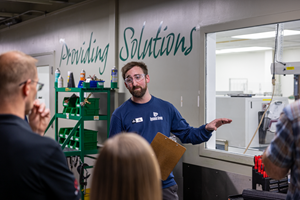Uncertainty in Automotive Market for 2019
It’s not clear yet how trade tensions and interest rates will affect stagnant vehicle sales.
If trade tensions escalate and interest rates increase throughout 2019, the automotive industry may find it harder than expected to expand. During 2018, the auto industry tracked along the same trajectory as the prior year. Unit sales data for 2018 showed growing preference for SUVs and light trucks over cars. This trend is not new: unit car sales peaked in June 2014 and have seen an average 7.5% annualized contraction in the 17 quarters since then. Truck and SUV sales continue to offset the weakness in car sales, keeping total vehicle sales since mid-2015 at a monthly average of 1.4 million units, or 17.3 million on an annual basis. Looking forward to 2019, there are several factors such as interest rates and tariffs that will have significant near-term effects on the automotive market.
This year is the third year that interest rates have increased, raising the cost of all loans. The latest data for 2018 indicates that the current vehicle interest rate of 6.16% is 10% higher than a year ago and over 22% higher than two years ago, when the average rate was just over 5%. Initially, these rate increases, which increase monthly finance payments, did not slow the growth in average financing amount, which peaked at over $30,500 during the first quarter of 2018. The latest data available in October showed the average amount financed has now fallen over 2%, or over $600 per vehicle.
Furthermore, recent tariff data indicates that new U.S. trade laws enacted during 2018 have produced asymmetrical effects that have hurt U.S. exports more than they have helped domestic sales. Seasonally adjusted figures from the Bureau of Economic Analysis indicate Canadian and Mexican imports of U.S. automobiles have declined 20% from a year ago. One would have to go back to 2011 to find such low levels of Canadian and Mexican imports of U.S. vehicles. The value of U.S. automotive manufacturing shipments in general between April and the latest available data from September indicates a 10% decline.
Although many of the latest trade regulations have had relatively little time to make their impact felt, the underwhelming change in U.S. import consumption is evident in automotive. The ratio of domestic to imported cars and trucks sold in the U.S. during the second half of 2018 indicated no shift in this ratio through October. The market share of imported vehicles sold in the U.S. during the second half of 2018 has yet to indicate a significant change.
The sheer number of factors impacting the automotive market make it difficult to predict the path of the automotive industry in 2019. If trade tensions escalate and interest rates increase throughout 2019, the automotive industry may find it harder than expected to expand.
ABOUT THE AUTHOR: Michael Guckes is the chief economist for Gardner Business Intelligence, a division of Gardner Business Media, Cincinnati. He has performed economic analysis, modeling and forecasting work for nearly 20 years among a wide range of industries. Guckes received his BA in political science and economics from Kenyon College and his MBA from The Ohio State University. mguckes@gardnerweb.com.
Related Content
Foam-Core Multilayer Blow Molding: How It’s Done
Learn here how to take advantage of new lightweighting and recycle utilization opportunities in consumer packaging, thanks to a collaboration of leaders in microcellular foaming and multilayer head design.
Read MoreMedical Molder, Moldmaker Embraces Continuous Improvement
True to the adjective in its name, Dynamic Group has been characterized by constant change, activity and progress over its nearly five decades as a medical molder and moldmaker.
Read MoreHow to Optimize Injection Molding of PHA and PHA/PLA Blends
Here are processing guidelines aimed at both getting the PHA resin into the process without degrading it, and reducing residence time at melt temperatures.
Read MoreIn Sustainable Packaging, the Word is ‘Monomaterial’
In both flexible and rigid packaging, the trend is to replace multimaterial laminates, coextrusions and “composites” with single-material structures, usually based on PE or PP. Nonpackaging applications are following suit.
Read MoreRead Next
People 4.0 – How to Get Buy-In from Your Staff for Industry 4.0 Systems
Implementing a production monitoring system as the foundation of a ‘smart factory’ is about integrating people with new technology as much as it is about integrating machines and computers. Here are tips from a company that has gone through the process.
Read MoreBeyond Prototypes: 8 Ways the Plastics Industry Is Using 3D Printing
Plastics processors are finding applications for 3D printing around the plant and across the supply chain. Here are 8 examples to look for at NPE2024.
Read MoreMaking the Circular Economy a Reality
Driven by brand owner demands and new worldwide legislation, the entire supply chain is working toward the shift to circularity, with some evidence the circular economy has already begun.
Read More
.jpg;width=70;height=70;mode=crop)











